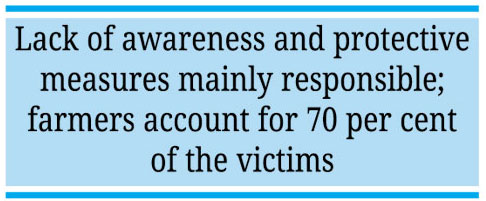
Deaths from lightning strikes on the rise
S M NAJMUS SAKIB | Saturday, 26 June 2021
 The number of deaths from lightning strikes has increased in the country in recent times mainly due to a lack of awareness among the people and protective measures by the authorities concerned, according to experts.
The number of deaths from lightning strikes has increased in the country in recent times mainly due to a lack of awareness among the people and protective measures by the authorities concerned, according to experts.
The people especially the farmers are not aware of lightning strikes at all, they said, adding that about 70 per cent of the total lightning strike victims are farmers.
Bangladesh is the third most lightning strike-prone region in the world due to its geographical location, according to meteorologists.
The government announced the lightning strike as a natural disaster in 2016 following a rising number of deaths. The government, however, said it has taken multilevel preparations to address the issue and protect the lives of people.
At least 225 people were killed by lightning strikes in the last six months until June 17 this year while 380 in 2020, according to Foundation for Disaster Forum.
Save the Society and Thunderstorm Awareness Forum said at least 177 people were killed during the period between March and June 7 this year. Of them, 122 were farmers.
Dr Shahriar Hossain, secretary of Environment and Social Development Organization, said people especially farmers die from lightning strikes due to a lack of awareness among them.
"We are lagging behind in incorporating modern technologies in neutralizing the lighting strike. We can install lightning rods on agricultural fields and areas prone to lightning strikes which can save the lives of hundreds of people."
He added: "We have to plant more trees along roads and highways, take up plantation programmes, and build shelters in coastal areas which can help save lives during lightning strikes and disasters."
"We have also found faulty electricity connections in buildings. Ignorance to follow building code is another major concern as faulty electric lines and lack of earthing system are causing deaths despite being inside during lightning," Dr Hossain elaborated.
Kawsar Parvin, Deputy Director, Storm Warning Centre at Bangladesh Meteorological Department (BMD), told the FE that the number of lightning strikes remained almost the same, but the number of deaths increased.
The number of tall trees including palm has declined sharply in the country, she added. "In cities, we use the earthing system as a protector from lightning, but the people in rural areas are not aware of it posing threat to their lives.''
"In an effort to protect the people, eight lightning forecast stations will be built with a central system to alert people before it happens," she added.
According to the Ministry of Disaster Management and Relief, the number of casualties remained stable until 2016 with less than 200 deaths on average. The number of deaths was 301in 2017 while 198 in 2019, 247 in 2020 and 201 until June 24 this calendar year.
Md Mohsin, secretary, ministry of disaster management and relief, told the FE that the ministry is dealing with the issue and working to mitigate the losses and damages.
"We have already planted more than four million palm trees across the country as these trees help neutralize lightning."
He added: "We are also working to build some stations to provide lightning forecasts, install lightning rods and other devices to neutralize lightning as methods to save the lives of people."